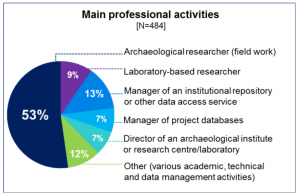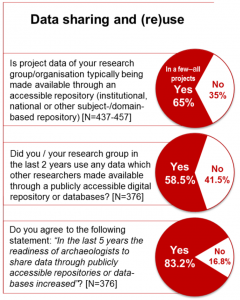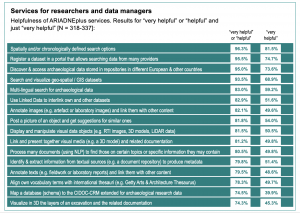Key results of the ARIADNEplus 2019 community needs survey
By Guntram Geser, Salzburg Research, Austria, 15.11.2019
ARIADNEplus has carried out a survey on the needs of the user community regarding data sharing, access and (re)use, new services (as developed by the project), and related training needs. Core groups addressed by the survey have been archaeological researchers and data managers/providers. Results are compared, where possible, to those of the ARIADNE 2013 survey and, particularly, to planned new data, technical and other services.
Survey responses and demographics
The survey was open for responses from May 25th to September 4th, 2019. 701 questionnaires were received of which 484 were sufficiently complete to be included in the analysis.
Countries & participation of ARIADNEplus partners: Responses were received from all 27 ARIADNEplus partner countries, including Argentina, United States, Japan, and Israel; a few other countries are also present. 93% of the respondents are professionally based in a European country; 46% said the organisation they work for is a member of the ARIADNEplus consortium.


Organisational background: 53% university or public research organisation, 19% museum, 15% governmental institution, 8% private company or research institute; 2% not affiliated with an organisation (e.g. self-employed, free-lancing), 3% other.
Main professional activities: 53% archaeological researcher (field work), 9% laboratory-based researcher, 13% manager of an institutional repository or other data access service, 7% manager of project databases, 7% director of an archaeological institute or research centre/ laboratory, 12% other (various academic, technical and data management activities).
Current position: 77% permanent employee, 9% post doc/project-related research contract, 6% Ph.D. student, 8% other (most mentioned an academic or professional position).
Male/female: With a share of 45%, female respondents are well represented in the survey sample.
Key survey results
More sharing of data through accessible repositories
In the ARIADNE 2019 survey, around 65% of respondents shared from some to all of their project data through an accessible repository (2013 around 50%). This is over 30% more than reported by other surveys with respondents from different disciplines, Tenopir et al. (2015) 30%, Figshare (2018) 33%.
Supplementary material
In the 2019 and 2013 ARIADNE/plus surveys, many respondents said that they make supplementary material available; 2019: 81% of 449 respondents, 2013: 82% of 520 respondents. In 2019, 13% in all or most, 25% in many, and 42% at least in a few projects (the percentages 2013 are roughly the same).
In other surveys the percentages were: Tenopir et al. (2015) 19.4%, Figshare (2017) 34%. The explanation for the much higher percentages in the ARIADNE/plus surveys could be that many of the respondents are obliged to provide fieldwork reports to a national heritage authority, and do this with supplementary material added.
Barriers to data deposition & sharing

In the 2013 ARIADNE and 2019 ARIADNEplus surveys, the participants were given a list of potential barriers for researchers to deposit their data in digital repositories and share it with others. The barriers which respondents perceived as most critical were the same, albeit with some differences regarding the percentages of “very” or “rather” important combined:
- A lack of professional recognition and reward: was considered as most critical by 75.5% of respondents in 2019, while 72% in 2013.
- The work effort for providing the data and metadata in the required formats: was an important barrier for 74% of respondents in 2019, while in 2013 more respondents worried about the work effort for metadata and data (80%).
- Intellectual property rights issues: was a concern for 75% of respondents in 2019, while significantly less in 2013 with 65%.
- Two barriers were perceived as somewhat less important with about the same percentages: Lack of appropriate repositories with 67% in 2019, while 66% in 2013; the cost for depositing data in a repository with 59% in both years.
Regarding professional recognition and reward for data sharing, in the latest Figshare survey (2018) the majority of respondents felt that they did not get sufficient credit for data sharing, 58%, compared to 9% who felt they do; 33% were not sure.

Increase of readiness to share data
The survey participants were asked if they agreed with the statement: “In the last 5 years the readiness of archaeologists to share data through publicly accessible repositories or databases increased”? – 83.2% of 376 respondents agreed. However, several respondents perceived a higher awareness among archaeologists that data should be made available, but little increase in readiness to do so. Others felt that the increase is taking place only slowly. More has to be done to foster data sharing.
Reuse of data
The survey participants were asked, “Did you / your research group in the last 2 years use any data which other researchers made available through a publicly accessible digital repository or databases?”. – An astonishing number of 220 respondents said they did and also briefly described the data types and/or the sources. The survey chapter on data reuse includes a list of 96 named sources from which respondents acquired data.
Main purposes of data reuse
The 220 respondents were asked “What was the main purpose of the data reuse?”, and three predefined purposes and the option “Other – please specify” offered. Building a database for the research community was a purpose for 31%, comparison to own results for 55%, and use together with own research data for 63% (multiple answers were possible). Few mentioned other purposes for the data (re)use, for example, to use it as test data (e.g. “test algorithms and approaches”) or as a conceptual resource (e.g. “typology terms”, “data structure”).
Online accessibility of data types
Survey respondents rated the current availability of the different types of data ARIADNEplus aims to mobilise and integrate into the dataset catalogue and portal. The analysis of the results showed:
- good availability: archaeological sites and monuments data (usually provided by heritage authorities), national GIS data and maps (from mapping agencies), and satellite or airborne remote sensing data (in Europe offered freely by the European Space Agency);
- less good availability: data and documentation from fieldwork (excavation, field survey/ prospection, fieldwork reports), and databases and catalogues of various artefacts (e.g. museum collections);
- poor availability: dating data (e.g. dendrochronology, radiocarbon) and scientific data/analysis of biological and inorganic remains); also the availability of environmental archaeology and maritime & underwater archaeology data was perceived as poor.
ARIADNEplus portal for data discovery & access
One particularly important objective of the survey was to identify if respondents perceive support by the ARIADNEplus portal to discover and access more helpful for some data types than for others. A comparison of the online accessibility rating of the data types and helpfulness of portal support for discovering and accessing datasets or collections of such data showed:
- surprisingly, the appreciation of support was lower for data types for which the accessibility was evaluated as insufficient;
- respondents were most appreciative of portal support for discovery and access of sites and monuments databases or inventories, national GIS data & maps, and satellite or airborne remote sensing data (e.g. LiDAR), although the online accessibility of these data types was rated much better than that of other data types;
- the rationale for ARIADNEplus could hardly be to prioritise support for data types which are already much more accessible than others; the fact that the more accessible types are being provided by national mapping and heritage authorities indicated ARIADNEplus should prioritise other data types.
ARIADNEplus special services for researchers and data managers

Some interesting survey results for the ARIADNEplus services for researchers and data managers are:
- Respondents appreciated services most which ARIADNE/plus already provides: Register a dataset in a portal that allows searching data from many providers; Discover & access archaeological data stored in repositories in different European & other countries; Spatially and/or chronologically defined search options.
- The appreciation of dataset registration could signal a high interest of survey respondents to make datasets available for search and access via the ARIADNEplus data portal.
- Search and visualize geo-spatial/GIS datasets: These services are the highest ranked among the new services, and are part of the plan of services ARIADNEplus will implement.
- Respondents were also particularly interested to “Use Linked Data to interlink own and other datasets” and services for working with visual content (e.g. 3D models, LiDAR imagery).
Training needs

Selected survey results regarding training needs:
- Training for the application of open/FAIR data principles in archaeology would be appreciated most, both by researchers and data managers, and ARIADNEplus is committed to support these principles within the archaeological sector.
- Significantly less appreciation was expressed for training in how to create and implement a data management plan (DMP), manage a digital repository, produce metadata and use domain vocabularies to describe archaeological datasets. Data science skills, managing datasets of a large archaeological project, and depositing project datasets in a digital repository were scored higher.
- That researchers are the largest group in the survey sample certainly had a considerable impact on the results. Researchers worry about additional data-related work, which explains why training regarding DMPs, metadata and vocabularies is appreciated less.
- Inconsistently, training on data deposition appeared to be welcome, despite the (not recognised) fact that this would require dealing with metadata and vocabularies. Awareness of an increasing expectation that data from funded research projects should be deposited may have contributed to this result.
References
Figshare (2018): The State of Open Data 2018, https://doi.org/10.6084/m9.figshare.7195058; interactive visualisation, https://knowledge.figshare.com/articles/item/state-of-open-data-2018; Dataset: https://ndownloader.figshare.com/files/13320101
Tenopir C., Dalton E.D., Allard S., Frame M., et al. (2015): Changes in Data Sharing and Data Reuse Practices and Perceptions among Scientists Worldwide. In: PLoS ONE, 10(8): e0134826, 26 August 2015, https://doi.org/10.1371/journal.pone.0134826; data in S1 Appendix, https://doi.org/10.1371/journal.pone.0134826.s001
Reports for downloading
Key results of the ARIADNEplus 2019 community needs survey (4 page summary, 0.3MB)
Community Needs Survey 2019 (Edited version of D2.1 focussing on the survey and results, 117 pages, 2.6MB)
D2.1 Initial Report on Community Needs (Full deliverable report, 141 pages, 3.7MB)

